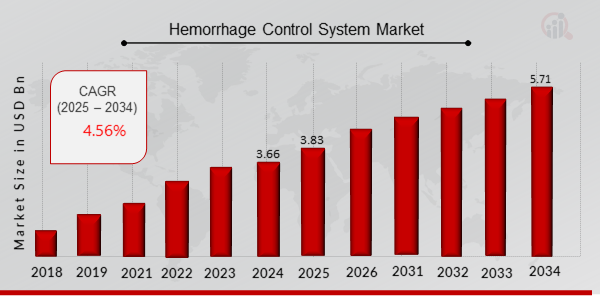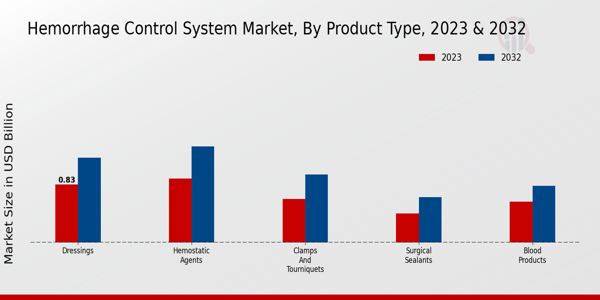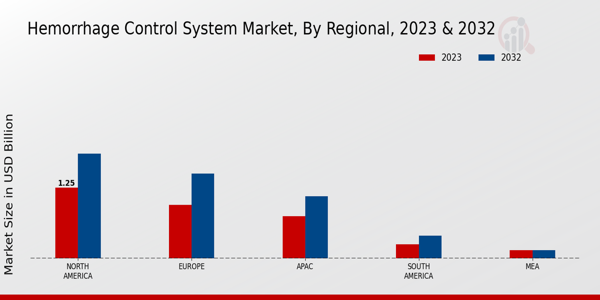Hemorrhage Control System Market Overview
As per MRFR analysis, the Hemorrhage Control System Market Size was estimated at 3.66 (USD Billion) in 2024. The Hemorrhage Control System Market Industry is expected to grow from 3.83 (USD Billion) in 2025 to 5.71 (USD Billion) till 2034, at a CAGR (growth rate) is expected to be around 4.56% during the forecast period (2025 - 2034).
Key Hemorrhage Control System Market Trends Highlighted
The Hemorrhage Control System Market is significantly influenced by various key market drivers. The rising incidence of trauma and surgical procedures has increased the demand for effective hemorrhage control solutions. This drives innovation and development in products that enhance patient outcomes and reduce mortality rates associated with severe bleeding. Additionally, the growing awareness of advanced medical technologies among healthcare professionals and patients is prompting greater adoption of hemorrhage control systems, thereby boosting market growth. Regulatory advancements that simplify product approval processes are also contributing to a positive market outlook, enabling faster delivery of new and improved solutions.There are numerous opportunities in the market that can be explored to capture growth. With an increasing focus on preventive healthcare and trauma management, there is a demand for novel solutions such as smart bandages and minimally invasive devices that can efficiently control bleeding. Additionally, expanding healthcare services in emerging economies presents a significant potential for market expansion. Collaboration between key players in the healthcare industry, such as manufacturers and healthcare providers, can lead to the development of innovative products to address specific needs, further enhancing market opportunities. Recent trends in the industry indicate a shift towards integrating advanced technology, such as artificial intelligence and telemedicine, into hemorrhage control systems.These advancements are aimed at improving response times in emergency situations and providing real-time data analysis. The focus is also on developing portable and easy-to-use products that can be utilized in both hospital and pre-hospital settings. Overall, the combination of demand for effective hemorrhage control solutions and technological advancements creates a dynamic landscape for growth in the Hemorrhage Control System Market. The evolving needs of patients and healthcare professionals will continue to shape this market in the coming years.

Source: Primary Research, Secondary Research, MRFR Database and Analyst Review
Hemorrhage Control System Market Drivers
Increasing Incidence of Trauma and Surgical Procedures
The rising incidence of traumatic injuries and the increasing number of surgical procedures play a significant role in driving the Hemorrhage Control System Market Industry. Trauma and surgeries often lead to substantial blood loss, necessitating effective hemorrhage control solutions. These injuries can arise from various causes, including road accidents, falls, and violence, as well as the need for surgical interventions in chronic conditions or emergencies.The growth in the number of surgical procedures, such as orthopedic, cardiovascular, and gastrointestinal surgeries, further fuels the demand for advanced hemorrhage control systems. Moreover, as advancements in medical technology continue to evolve, surgical techniques are becoming more complex, which could result in increased risks of hemorrhagic complications. There is a pressing need for innovative products that can ensure effective management of blood loss during these events, subsequently propelling the Hemorrhage Control System Market.Market players are focusing on developing advanced products, including hemostatic agents, tourniquets and surgical devices, thus contributing to market growth. Additionally, the growing prevalence of conditions that may require surgeries, such as obesity and cardiovascular diseases, contributes to the demand for effective hemorrhage control solutions. Such market dynamics suggest a robust potential for growth in the Hemorrhage Control System Market in the coming years.
Technological Advancements in Hemorrhage Control Systems
The Hemorrhage Control System Market Industry is significantly driven by rapid technological advancements and innovations in hemorrhage control devices. The introduction of advanced surgical tools, along with more effective hemostatic agents, has augmented the efficiency of hemorrhage control procedures. Many companies are investing in research and development to create next-generation products that are more effective, user-friendly, and suitable for a variety of medical environments.Enhanced product features such as improved materials, real-time monitoring systems, and portability position these devices favorably in clinical settings, thereby boosting their adoption rates. The continuous enhancement of technology provides better outcomes in emergency and surgical situations, increasing the reliability of hemorrhage management solutions.
Government Initiatives and Funding in the Healthcare Sector
Governmental support and initiatives aimed at improving healthcare infrastructure and trauma care systems are becoming increasingly important for the Hemorrhage Control System Market Industry. Many countries are investing substantial resources in developing healthcare facilities, specifically targeting trauma centers and emergency medical systems. Such investments involve increased funding for research on hemorrhage control techniques and resources allocated to emergency preparedness programs.This financial backing promotes the development and distribution of advanced hemorrhage control technologies, ensuring that healthcare providers are equipped with the necessary tools for effective intervention. Furthermore, government policies focusing on enhancing patient safety and improving outcomes in trauma care naturally align with the growth of the hemorrhage control system segment within the medical industry.
Hemorrhage Control System Market Segment Insights:
Hemorrhage Control System Market Product Type Insights
The Hemorrhage Control System Market offers a diverse range of product types that are essential in managing bleeding in various medical scenarios. In 2023, the overall market is valued at approximately 3.35 USD Billion, which reflects substantial investment and focus in this crucial area of healthcare. Looking closely at the product types, Dressings represent a significant portion of the market, valued at 0.827 USD Billion and projected to grow to 1.21 USD Billion by 2032.
This segment is critical as advanced dressings enhance the body's natural healing processes and are vital in trauma care, which contributes to their majority holding within the market. Hemostatic Agents follow closely with a valuation of 0.91 USD Billion in 2023, expected to increase to 1.371 USD Billion by 2032. These agents are significant as they work to accelerate clot formation, proving essential in surgeries and emergency care, thus driving their rapid growth.
The Clamps and Tourniquets segment is valued at 0.62 USD Billion in 2023 and is projected to reach 0.968 USD Billion by 2032. This product type plays a crucial role in controlling severe bleeding, making it highly important in both pre-hospital settings and surgical procedures. Surgical Sealants are another important product type within the market, with a valuation of 0.414 USD Billion in 2023, anticipated to grow to 0.645 USD Billion by 2032. They are essential in various surgical procedures, sealing wounds and reducing bleeding, which adds to their significance in the industry. Lastly, Blood Products hold a market value of 0.579 USD Billion in 2023, expected to grow to 0.806 USD Billion by 2032.
They are critical for resuscitation and replenishing lost blood, emphasizing their importance in emergency and surgical care. The market segmentation reflects the essential components of the Hemorrhage Control System Market, showcasing diverse products that are integral to effective bleeding management. The growth statistics demonstrate the increasing focus on innovation and development in these essential product areas, highlighting opportunities within the healthcare sector for advancements in hemorrhage control.

Source: Primary Research, Secondary Research, MRFR Database and Analyst Review
Hemorrhage Control System Market Application Insights
The Application segment encompasses critical areas such as Trauma Surgery, Cardiac Surgery, Orthopedic Surgery, General Surgery and Gynecological Surgery. Trauma Surgery notably holds a significant position, attributed to the rising incidence of traumatic injuries and the need for rapid hemorrhage control. Cardiac Surgery also dominates due to increased cardiac procedures and advanced surgical techniques.Orthopedic Surgery remains essential, driven by the growing number of orthopedic surgeries requiring effective hemorrhage management. The General Surgery sector, with its wide range of procedures, underscores the versatile need for hemorrhage control systems. Gynecological Surgery is increasingly recognized for its specific hemorrhage challenges, creating opportunities for specialized innovations within the market. Overall, the Hemorrhage Control System Market segmentation reflects a comprehensive strategy to address diverse surgical needs driven by factors such as an aging population, rising healthcare expenditures, and advances in surgical technologies.Market growth is supported by increasing awareness of rapid hemorrhage control solutions across various healthcare settings.
Hemorrhage Control System Market End Use Insights
The Hemorrhage Control System Market is experiencing steady growth driven by various end-use sectors. Hospitals represent a significant portion of the overall market, playing a vital role due to their critical care capabilities and high volume of trauma cases. Ambulatory Surgical Centers contribute meaningfully as well, offering efficient treatment options that directly impact patient outcomes. Emergency Medical Services are essential for timely intervention in traumatic situations, further elevating their importance in the hemorrhage control landscape.Home Healthcare is emerging as a growing sector, driven by the rising trend of at-home medical care and the need for accessible hemorrhage management tools. The diversity in end-use applications underscores the Hemorrhage Control System Market’s resilience and adaptability to different healthcare settings, providing ample opportunities for innovation and market growth. As stakeholders navigate the challenges of this market, leveraging effective hemorrhage control systems can lead to improved patient safety and outcomes across these vital segments.
Hemorrhage Control System Market Distribution Channel Insights
The market segmentation indicates a dynamic landscape involving Direct Sales, Distributors, Online Retail and Pharmacies. Direct Sales and Distributors tend to dominate the market due to their ability to maintain close relationships with medical institutions and offer tailored solutions. This channel is vital for ensuring quick access to products required in critical situations.Online Retail is gaining momentum, supported by increasing digitalization in healthcare and the convenience it offers to consumers, making it a significant player in expanding market reach. Pharmacies also play a crucial role by providing immediate access to hemorrhage control products, especially for patients requiring at-home care. The cooperative synergy among these channels facilitates efficient product distribution, thus enhancing the Hemorrhage Control System Market revenue while contributing to its projected growth. Understanding these functionalities and trends assists stakeholders in identifying lucrative opportunities within the market.
Hemorrhage Control System Market Regional Insights
The Hemorrhage Control System Market is projected to showcase considerable growth across various regions, with North America leading the charge with a valuation of 1.25 USD Billion in 2023, expected to reach 1.85 USD Billion by 2032, reflecting its majority holding in the market. Europe follows with a significant value of 0.95 USD Billion in 2023, rising to 1.5 USD Billion in 2032, driven by advancements in medical technology and increased investment in healthcare infrastructure. The APAC region, valued at 0.75 USD Billion in 2023 and projected to grow to 1.1 USD Billion by 2032, is gaining momentum due to rising awareness and improving medical facilities.South America presents a smaller yet notable segment, with its market valued at 0.25 USD Billion in 2023, rising to 0.4 USD Billion by 2032, reflecting growing healthcare needs. Lastly, MEA remains constant at 0.15 USD Billion, indicating challenges in market penetration. This regional segmentation highlights the varying dynamics and growth opportunities present in the Hemorrhage Control System Market, influenced by healthcare policies and technological advancements.

Source: Primary Research, Secondary Research, MRFR Database and Analyst Review
Hemorrhage Control System Market Key Players and Competitive Insights:
The Hemorrhage Control System Market is a rapidly evolving sector that plays a critical role in emergency medicine, trauma care and surgical procedures. As the demand for efficient and reliable hemorrhage control solutions increases, the market is witnessing heightened competition among key players striving to innovate and expand their product offerings. This market is characterized by a mix of established companies and emerging startups, each vying for market share through technological advancements, strategic partnerships, and aggressive marketing strategies. The landscape is further influenced by factors such as rising awareness of trauma care, increased investment in healthcare infrastructure, and a growing emphasis on patient outcomes. With the ongoing advancements in medical technologies and materials, companies are continuously seeking to enhance the efficacy and usability of their hemorrhage control systems to cater to the diverse needs of healthcare providers and patients.Baxter International is recognized for its strong presence in the Hemorrhage Control System Market, leveraging its extensive experience and a robust portfolio of products designed for effective hemorrhage management. The company has developed innovative solutions that focus on patient safety and improved clinical outcomes, reflective of its commitment to transformative healthcare. Baxter International's strengths lie in its comprehensive research and development initiatives, allowing it to stay ahead in technology and develop cutting-edge products that address the complexities of hemorrhage control. The company’s established distribution networks further enhance its ability to deliver essential medical devices and solutions to a global audience. Additionally, Baxter’s ongoing partnerships and collaborations with healthcare professionals enable it to gather valuable insights, driving product optimization and customer satisfaction. This solid foundation facilitates Baxter International's competitive edge, positioning it as a leader in the hemorrhage control system domain.ZMedica is another key player in the Hemorrhage Control System Market, known for its focus on innovative technologies that enhance critical bleeding management. The company specializes in advanced hemostatic agents designed to provide rapid and effective control of bleeding, particularly in emergency medical situations. ZMedica's unique products are evidence-based and developed through comprehensive research, ensuring that they meet the needs of modern healthcare providers. Its commitment to continuous improvement and responsiveness to healthcare needs strengthens the competitive position of ZMedica in the market. Furthermore, ZMedica's efforts in education and training for healthcare professionals underscore its dedication to effective hemorrhage control practices, ensuring that its products are utilized to their full potential in critical settings. The company's operational strategies and emphasis on quality assurance contribute to its reputation as a trusted entity in hemorrhage management solutions, making it an important player in the industry.
Key Companies in the Hemorrhage Control System Market Include:
- Baxter International
- ZMedica
- Tactical Medical Solutions
- Johnson and Johnson
- Medtronic
- North American Rescue
- Combat Medical Systems
- RevMedx
- Smiths Medical
- Arterial Graph
- Hemasorb
- Hemcon Medical Technologies
- Stryker
- Celox Medical
Hemorrhage Control System Market Industry Developments
The Hemorrhage Control System Market is experiencing significant advancements as companies like Baxter International, ZMedica, Tactical Medical Solutions, Johnson & Johnson, and Medtronic continue to innovate and expand their product lines. Recent developments include increasing investments in research and development to enhance existing products and introduce new technologies for effective trauma care. The demand for these systems is further stimulated by the rising prevalence of trauma cases and the ongoing need for efficient pre-hospital care.
Current affairs reveal a growing emphasis on strategic collaborations and partnerships among major players for developing cutting-edge solutions in hemorrhage control. In terms of market valuation, many companies, including North American Rescue and Stryker, have witnessed robust growth attributed to an uptick in military and emergency medical service contracts. Furthermore, acquisitions are reshaping the landscape, with companies like Combat Medical Systems and RevMedx identifying strategic opportunities to reinforce their market positions and expand their capabilities. The landscape remains dynamic, driven by technological advancements and a focus on improving patient outcomes through effective hemorrhage management solutions.
Hemorrhage Control System Market Segmentation Insights
- Hemorrhage Control System Market Product Type Outlook
- Dressings
- Hemostatic Agents
- Clamps and Tourniquets
- Surgical Sealants
- Blood Products
- Hemorrhage Control System Market Application Outlook
- Trauma Surgery
- Cardiac Surgery
- Orthopedic Surgery
- General Surgery
- Gynecological Surgery
- Hemorrhage Control System Market End Use Outlook
- Hospitals
- Ambulatory Surgical Centers
- Emergency Medical Services
- Home Healthcare
- Hemorrhage Control System Market Distribution Channel Outlook
- Direct Sales
- Distributors
- Online Retail
- Pharmacies
| Report Attribute/Metric |
Details |
|
Market Size 2024
|
3.66 (USD Billion)
|
|
Market Size 2025
|
3.83 (USD Billion)
|
|
Market Size 2034
|
5.71 (USD Billion)
|
|
Compound Annual Growth Rate (CAGR)
|
4.56 % (2025 - 2034)
|
|
Report Coverage
|
Revenue Forecast, Competitive Landscape, Growth Factors, and Trends
|
|
Base Year
|
2024
|
|
Market Forecast Period
|
2025 - 2034
|
|
Historical Data
|
2020 - 2024
|
| Market Forecast Units |
USD Billion |
| Key Companies Profiled |
Baxter International, ZMedica, Tactical Medical Solutions, Johnson and Johnson, Medtronic, North American Rescue, Combat Medical Systems, RevMedx, Smiths Medical, Arterial Graph, Hemasorb, Hemcon Medical Technologies, Stryker, Celox Medical |
| Segments Covered |
Product Type, Application, End Use, Distribution Channel, Regional |
| Key Market Opportunities |
1. Technological advancements in devices, 2. Rising demand in emergency care, 3. Increased military applications, 4. Growing prevalence of trauma cases, 5. Expansion in developing regions |
| Key Market Dynamics |
1. Rising trauma cases, 2. Advancements in technology, 3. Increasing military spending, 4. Growing elderly population, 5. Enhanced awareness and training |
| Countries Covered |
North America, Europe, APAC, South America, MEA |
Frequently Asked Questions (FAQ) :
The Hemorrhage Control System Market is expected to reach a valuation of 5.71 billion USD by 2034 .
The Hemorrhage Control System Market is projected to grow at a CAGR of 4.56% from 2025 to 2034.
North America holds the largest market share in the Hemorrhage Control System Market, valued at 1.25 billion USD in 2023.
The Dressings segment is expected to grow significantly, increasing from 0.827 billion USD in 2023 to 1.21 billion USD by 2032.
Key players in the market include Baxter International, ZMedica, Tactical Medical Solutions, Johnson and Johnson, and Medtronic.
The European market is expected to grow from 0.95 billion USD in 2023 to 1.5 billion USD by 2032.
The market value for Hemostatic Agents is expected to reach 1.371 billion USD by 2032.
Surgical Sealants are projected to have the lowest market value in 2023, valued at 0.414 billion USD.
The APAC region is anticipated to reach a market size of 1.1 billion USD by 2032.
The expected market size of the Blood Products segment is projected to be 0.806 billion USD by 2032.

















